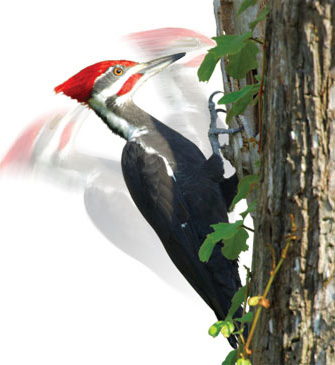Woodpecker head-banging wonder
Update (posted October 2023)
Recent research* shows that the spongy material in a woodpecker’s skull does not act like a shock absorber. Engineering analysis of high-speed video recordings showed that the skull’s deceleration was not slower than that of the beak penetrating the wood.
The woodpeckers’ small skull and the way in which its brain is arranged, tightly packed with minimal cerebral fluid, combined with the very short duration of each ‘peck’ and the short travel of the beak, means that the woodpecker operates within the limits of brain damage from the forces experienced.
Other aspects of the woodpecker, such as its super-long tongue with its special storage sheath, its nerves and musculature that enable rapid pecking, as well as the innate behaviour, and the strength of the beak and skull, are all design features that work together to make woodpeckers such a successful created kind.
*Biewener, A.A., Physiology: Woodpecker skulls are not shock absorbers, Current Biology 32:R767–R790, July 25, 2022 | doi.org/10.1016/j.cub.2022.06.037.
Woodpeckers hammer wood with their bills. They drill holes in trees when foraging, or to excavate storage holes or cavity nests.
The pecking impact forces are huge. The woodpecker’s head suddenly comes to an abrupt halt when the beak hits the wood, resulting in deceleration forces of the order of 1,200 g (i.e. 1,200 times the force of gravity).1 In stark contrast, just 300 g will leave a human concussed or with serious brain injury. Some woodpeckers might even be able to tolerate impact forces up to 6,000 g!2 And this is repeated head-bashing—around 18 to 22 times per second3—yet with no sign of blackout or brain damage.
A major challenge confronting engineers has been the need for a new shock-absorbing system for protecting micro-devices, i.e. improving g-force tolerance for use in high-g environments. Amazed at the woodpecker’s head-banging resilience, a team of engineers investigated its “advanced shock-absorbing mechanism”.1,4
With the help of x-ray computed tomography (CT) images of the woodpecker’s skeletal structures, the engineers highlighted the shock-absorbing capacities of:
- The beak made of elastic material
- The hyoid (muscles and tendons supporting the throat and tongue and reinforcing the head)
- A spongy bone specially located behind the beak
- A special skull bone containing spinal fluid
These features “stand in a row”, sequentially cushioning and dissipating the “mechanical excitations”, preventing brain injury.1 Other researchers confirm that it is the combined effect of these features that confers protection, rather than any single factor.5,6
Inspired by the woodpecker’s shock-absorbing spongy bone and hyoid, the engineers used the same principles with metal and elastic substances to design a shock-absorption system to protect commercial micro-devices.
When tested at 60,000 g, the woodpecker-inspired technology reduced the failure rate of micro-devices to just 0.7%, compared to 26.4% for conventional shock-absorption methods—a great design improvement.1 These same principles from woodpecker anatomy could guide the design of more effective helmets and other protective headgear.5
Looks like engineers can recognize good design when they see it.7 So should we all (Romans 1:20).
References and notes
- Yoon, S.-H. and Park, S., A mechanical analysis of woodpecker drumming and its application to shock-absorbing systems, Bioinspiration & Biomimetics 6:016003, 17 January 2011. Return to text.
- Gibson, L., Woodpecker pecking: how woodpeckers avoid brain injury, Journal of Zoology 270(3):462-465, 2006. Return to text.
- Sometimes even faster, e.g. the ladder-backed woodpecker is known to strike a tree as fast as 28.4 beats per second, and this drumming is repeated 500 to 600 times per day. Ref. 1. Return to text.
- They also lauded its beak as “a specialized chisel effective in cutting into a tree; unlike a human-made chisel, the beak is self-sharpening”—ref. 2. Return to text.
- Wang, L. and five others, Why do woodpeckers resist head impact injury: a biomechanical investigation, PLoS ONE 6(10):e26490, 2011. Return to text.
- So, in the first woodpecker, all features would have had to have been in place already. For other examples of irreducible complexity, see creation.com/irred-complex. Return to text.
- For more examples of engineers copying design in nature, see creation.com/biomimetics. Return to text.



Readers’ comments
Comments are automatically closed 14 days after publication.